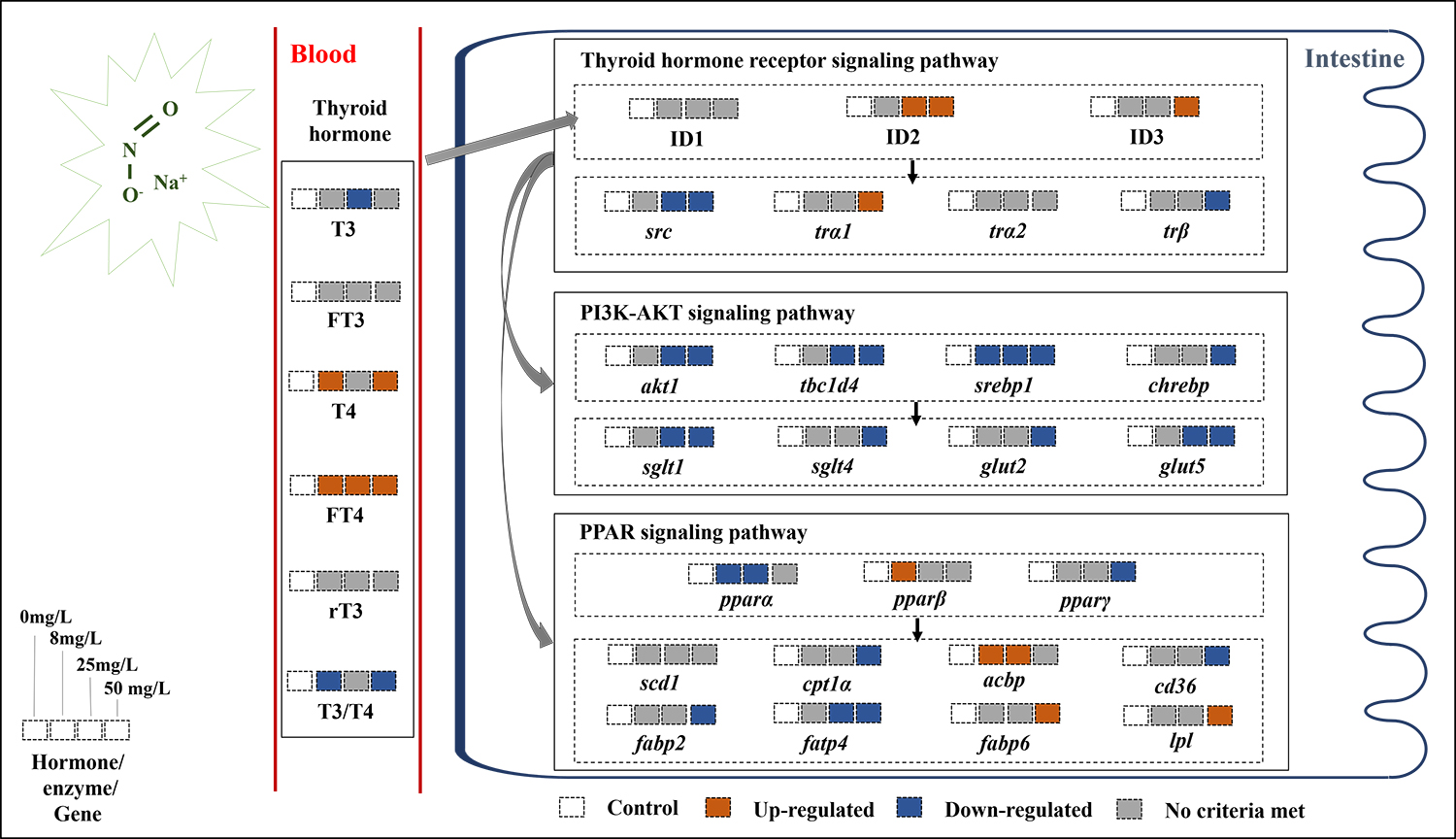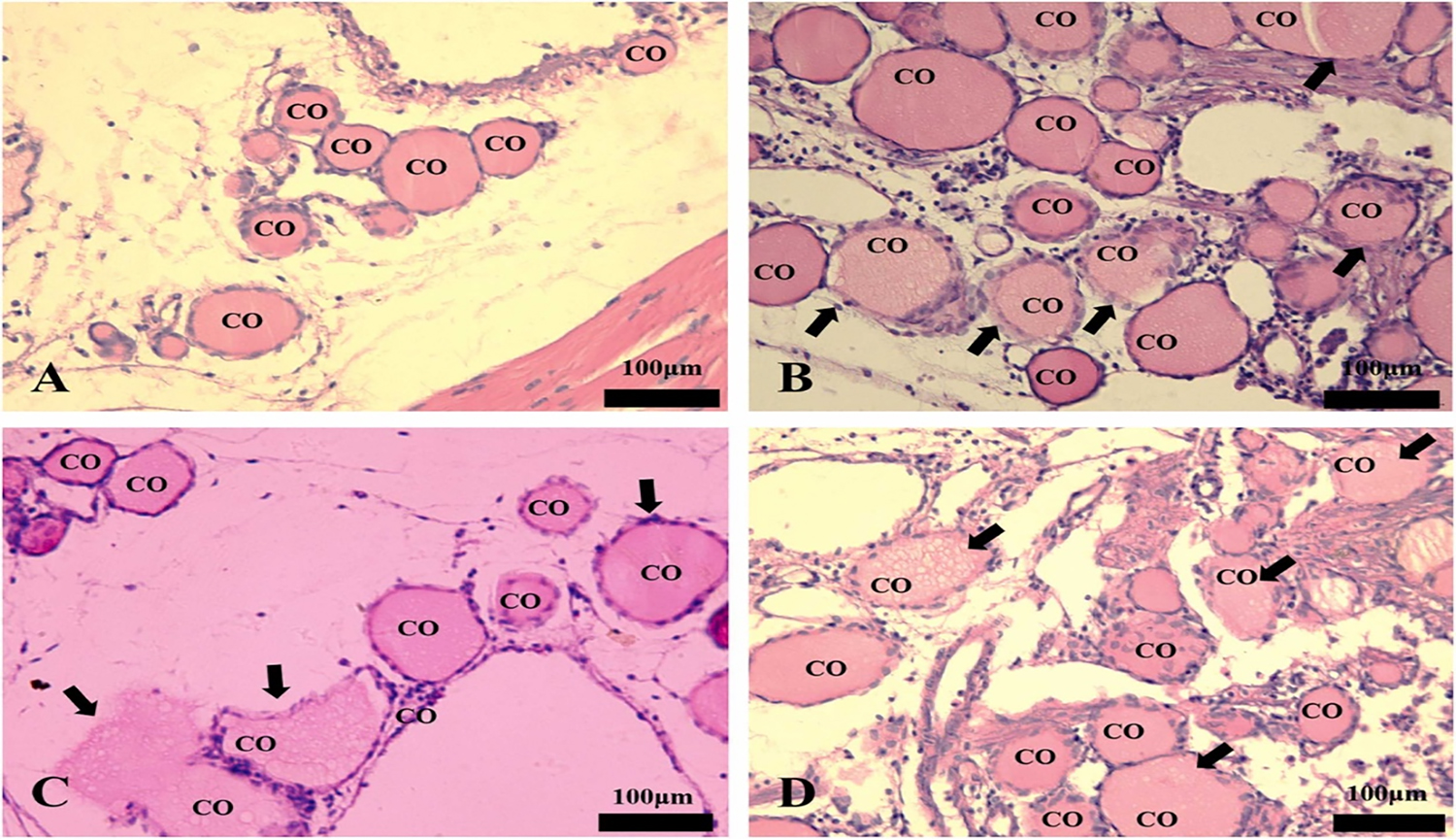南湖新闻网讯(通讯员 梁骁)近日,我校池塘健康养殖湖北省工程实验室李大鹏教授团队在Ecotoxicology and Environmental Safety发表了题为“Acute nitrite exposure interferes with intestinal thyroid hormone homeostasis in grass carp (Ctenopharyngodon idellus)”的研究论文。该研究以草鱼为研究对象,发现了养殖环境中亚硝酸盐浓度升高会通过干扰鱼体甲状腺机能来影响肠道营养有效利用。
高密度集约化水产养殖条件下,养殖中后期随着投饵量的加大、鱼虾排泄物的增多,残饵、粪便腐烂发酵及外源性氮元素的引入,易造成养殖水质恶化,致使亚硝酸盐偏高。鱼类亚硝酸盐中毒常表现出缺氧、摄食量下降、生长缓慢、体力衰退、鳃部受损变黑等症状,严重影响鱼类健康品质。以往研究多集中在亚硝酸盐导致鱼体缺氧症状机理方面,而亚硝酸盐干扰鱼体营养利用机制的研究却鲜有报道。同时肠道是重要的营养吸收器官,亦是甲状腺激素调控的关键靶点。
水环境亚硝酸盐暴露干扰草鱼肠道TR-Akt/PPAR信号通路简谱

水环境亚硝酸盐暴露导致草鱼甲状腺滤泡空泡化
研究发现养殖环境中的亚硝酸盐浓度升高会扰乱外周组织中的甲状腺激素代谢平衡,而亚硝酸盐是否通过干扰鱼类肠道甲状腺代谢平衡来影响营养吸收则需要明确。该研究团队以草鱼为研究对象,发现亚硝酸盐的毒性效应可以显著提升鱼体血清甲状腺素(T4)含量与肠道脱碘酶(IDs)活性,表明肠道甲状腺激素代谢稳态受到了干扰;团队进一步对调控肠道营养吸收相关信号通路进行分析,发现干扰效应通过TR-Akt/PPAR信号通路抑制肠道糖类、脂类营养素转运的同时促进了肠道的能量消耗。该研究为深入了解亚硝酸盐对鱼类甲状腺代谢的干扰作用及机制提供基础数据,并为养殖环境的控制和鱼类健康养殖提供基础依据。
我校水产学院博士研究生梁骁为论文第一作者,水产学院汤蓉与李大鹏为论文通讯作者。该研究得到了国家自然科学基金和国家重点研发计划等项目的资助。
审核人:李大鹏
【英文摘要】
Nitrite in the aquatic environment potentially disturbs thyroid hormone (TH) homeostasis in peripheral tissues, but little is known about TH metabolism in the intestine. This study investigated the serum concentrations of THs and thyroid-stimulating hormone as well as the activity of intestinal iodothyronine deiodinases (IDs) of grass carp (Ctenopharyngodon idellus) exposed to various concentrations of nitrite (0, 8, 25, or 50 mg/L) for 96 h. Acute nitrite exposure significantly altered the triiodothyronine (T3) levels and the morphology of thyroid follicles at 96 h, and thyroxine (T4) and free T4 levels and intestinal IDs activities showed an increase trend under nitrite stress. After 96 h exposure, nitrite down-regulated the expressions levels of intestinal Akt1 protein, sugar transporter genes, and thyroid hormone receptor (TR) signaling pathway genes except for trɑ1 and trɑ2. Moreover, the expressions levels of pparγ, cpt1α, cd36, fabp2 and fatp4 were down-regulated, whereas fabp6 and lpl were up-regulated in the 50 mg/L exposure group at 96 h. The results indicate that acute nitrite exposure has the potential to disturb the homeostasis of intestinal TH metabolism, which in turn alters TRs genes transcription, down-regulates sugar transporter activities, and promotes the energy expenditure in gut of grass carp.
论文链接:

